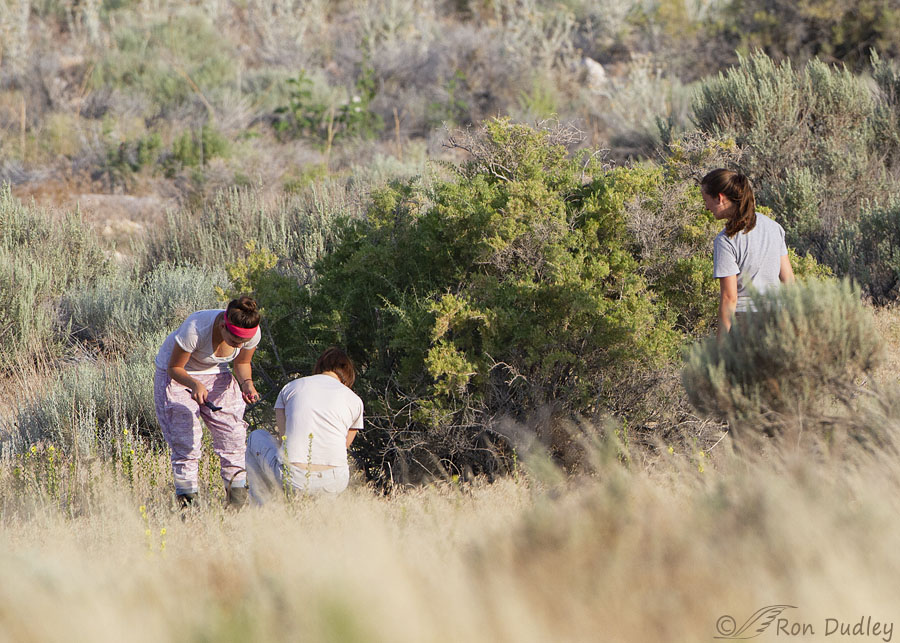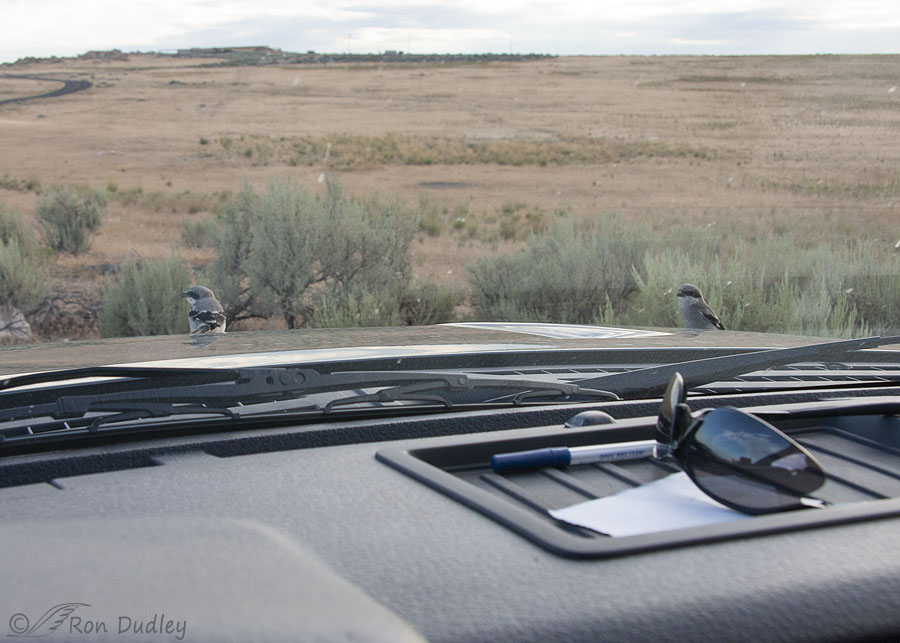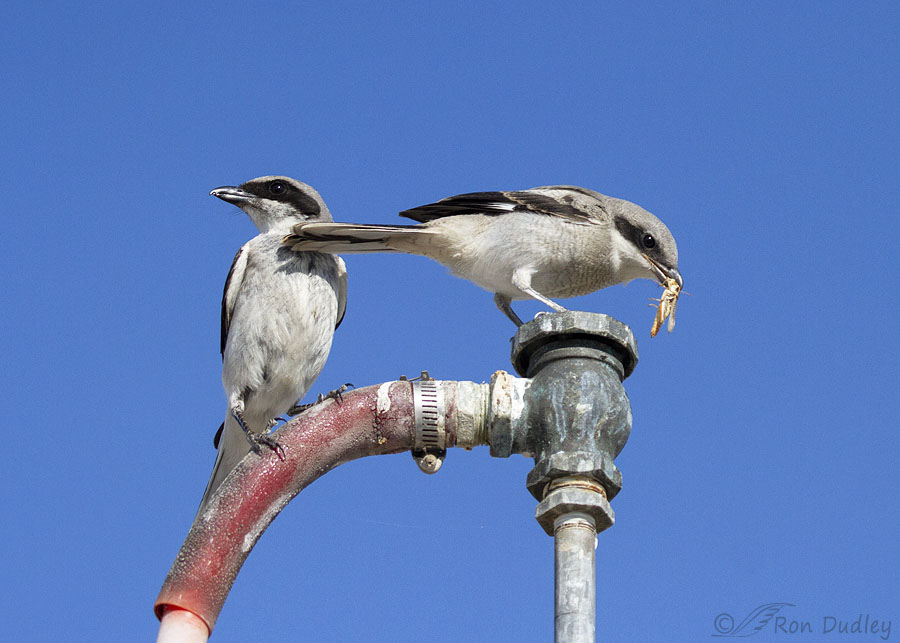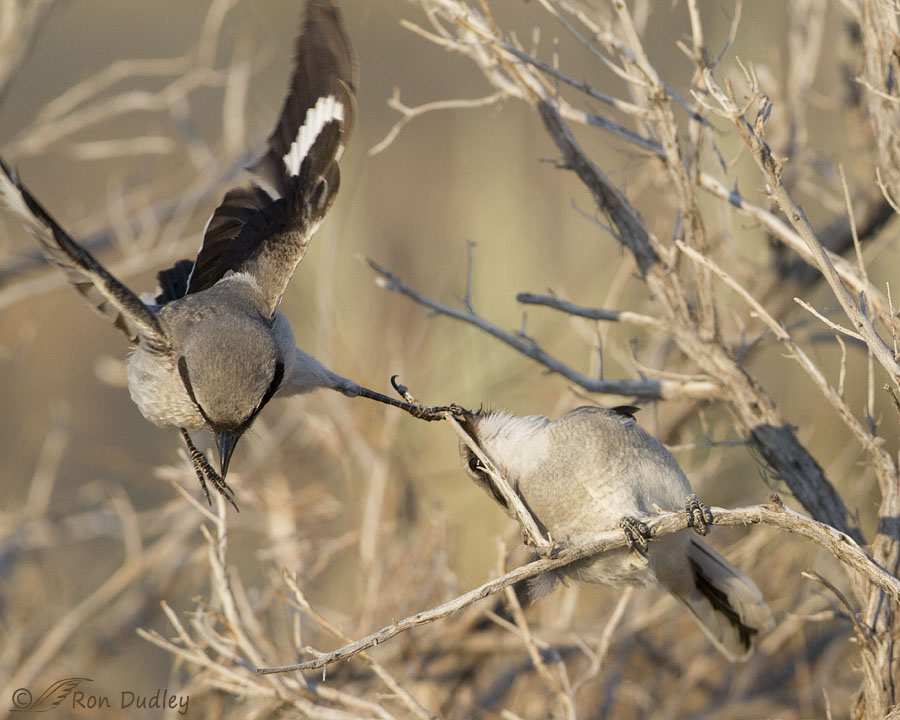Loggerhead Shrikes used to be abundant on the island and man were they ever fun to photograph.
Yesterday I posted a couple of photos of a Chukar on Antelope Island. Chukars used to be common on the island but no longer. And that disturbing trend reminded me of another bird on the same sinking boat – the Loggerhead Shrike.

Up until about six or seven years ago the north end of the island was reliable for shrikes for much of the year. I could usually count on seeing many of them, and photographing several, on a single tour of the north loop road. June and early July were especially active with shrikes because of their nesting activities with adults carrying nesting material (including bison fur) and feeding their chicks in their nests. And then when the chicks fledged things got really exciting. Young shrikes are boisterous, brazen and perpetually hungry – a bird photographer’s dream.
In early July of 2013 Westminster College’s Great Salt Lake Institute was conducting a study of mercury compounds in the food web of the Great Salt Lake and one of their focuses was to monitor Loggerhead Shrike populations because shrikes eat the spiders that eat brine flies that have hatched in the lake. Shrike numbers were so dense on the north end of the island I regularly saw GSLI staff banding shrike chicks just before they fledged.
Here the young lady on the left has a chick in one hand and a measuring device in the other while one of her companions records data and the other one appears to be looking for another chick in the bush. I have mixed feelings about banding young birds but I thought this photo was indicative of the healthy shrike population on the island just a few years ago.

Three days after the previous photo was taken I had an absolute blast with recently fledged shrike chicks at the pullout for the RV dump station on the island.
The chicks were nothing if they weren’t ballsy – here two of the youngsters had landed on the hood of my pickup. They also landed on my roof (I could hear their little claws on the sheet metal), my tailgate and both of my outside mirrors. When one of them landed on my driver’s side mirror I had my window open so I could have reached out and touched it if it had allowed me to do so. No, I didn’t try.

The siblings seemed to get along fine unless there was food involved and then they became competitive and aggressive. This bit of plumbing at the dump station became a coveted perch for the chicks while they were waiting for a food delivery from one of their parents, possibly because the perch was small enough that it could easily be defended from other hungry chicks.
Here the adult on the left has just delivered a grasshopper to the chick on the right.

But when they were waiting in one of the bushes at the dump station for a food delivery things became much more competitive. Just before this photo was taken the two chicks had been perched next to each other but when one of the parents approached with food the youngster on the right became aggressive and grasped its sibling’s toe in its beak. Even when the poor bird tried to escape the aggressor wouldn’t let go.
I spent several mornings photographing young shrikes and their parents at the dump station and I’ll never forget that experience.
But the shrike population on the island began to plummet in about 2015 and that trend has continued to this day. I seldom see shrikes on the island anymore. If it tells you anything I believe the last “new” shrike photo I’ve posted to Feathered Photography that was taken on the island was taken in 2018. I still see them occasionally but not very often.
I strongly believe the primary reason for their plummeting numbers can be directly tied to our mismanagement of water combined with our ongoing and severe drought, resulting in the dramatic decline of the Great Salt Lake.
I hate to end on downer but that’s the way it is.
Ron


What an incredible experience you had with the fledglings.
The Audubon Climate Vulnerability report says “The Loggerhead is gradually disappearing from many areas, for reasons that are poorly understood.”
The reason seems pretty obvious in your area. Only slightly less obvious everywhere else, I’d say.
I’d say the same thing, Lyle.
Great story, images and sad conclusion.
At 85, once a Trip Guide, a semi-survivalist, bird-bander, Naturalist, teacher, etc., I have seen a ton of mistakes by humans, some I’ve committed myself. But, I tried NOT to make those mistakes at the cost of wildlife, wild-things, life outside of my family. I am really very sad how humans are in the process of hurting (I’d use stronger language here) all life on this planet.
Thanks, Dick. Sounds like you’ve had quite a life. I’ll bet you could tell some stories…
Hiss and spit. I often despair at the greed and the stupidity of our species.
And thank you for sharing this magical morning.
Thanks, EC.
It’s not a downer when it’s true. More like a “WTF People!!!!”
Can’t argue with that, Kathleen.
I’ve been missing them too. Thanks for posting these photos.
A lot of us have been missing them, Deedee. The island just isn’t the same anymore, for that and other reasons.
A sad commentary on our stupidity.
Yup.
Stupidity, greed and short-sightedness.
That’s a big part of it, EC.
Interesting story and photos Ron. So funny those little guys all over your pickup. I too have mixed feelings about banding little birds. I really don’t like banding of any birds or animals, but then we have learned so much from tracking banded birds and animals. I only see one or two Shrikes here annually. We show them here as uncommon and irregular.
Thanks, Everett. It was so weird, and wonderful, to see that little guy on top of my mirror less than 2′ in front of my face!
What a fun experience! They think they have the world by the ass at that age it seems…..
They think they have the world by the ass at that age it seems…..  Sad that they have disappeared.
Sad that they have disappeared.  Tho never plentiful here, I haven’t seen one in years.
Tho never plentiful here, I haven’t seen one in years.
One day there will be a “what happened?” when some wake up and it’s too late for many…..
Thanks, Judy. I only remember seeing a single shrike on the MT farm, maybe 13 years ago.